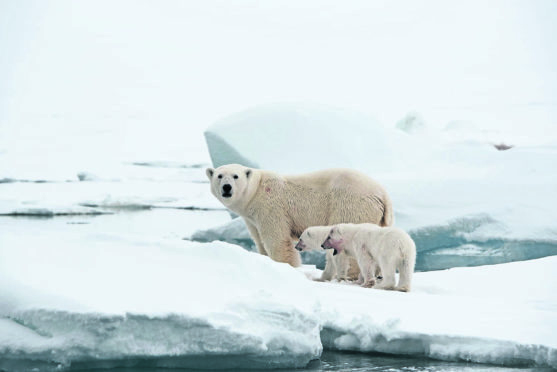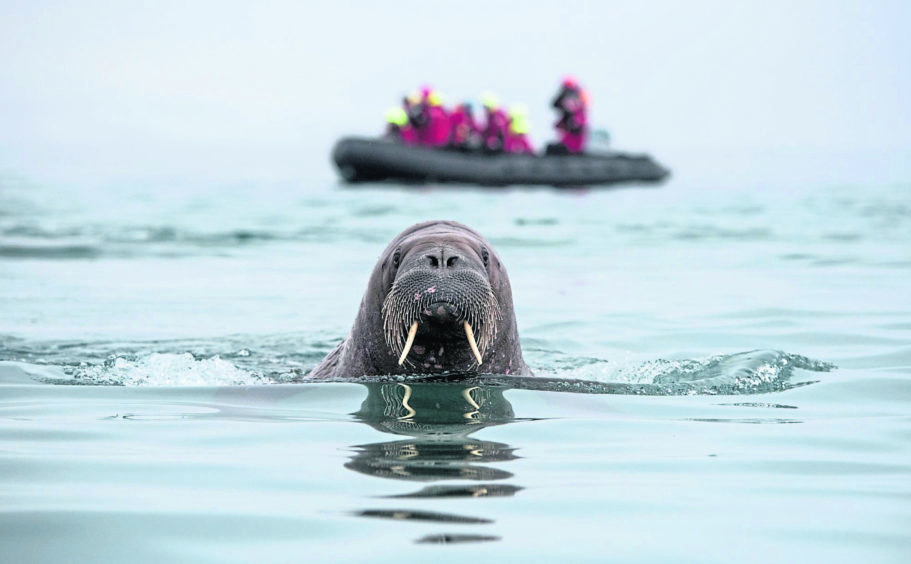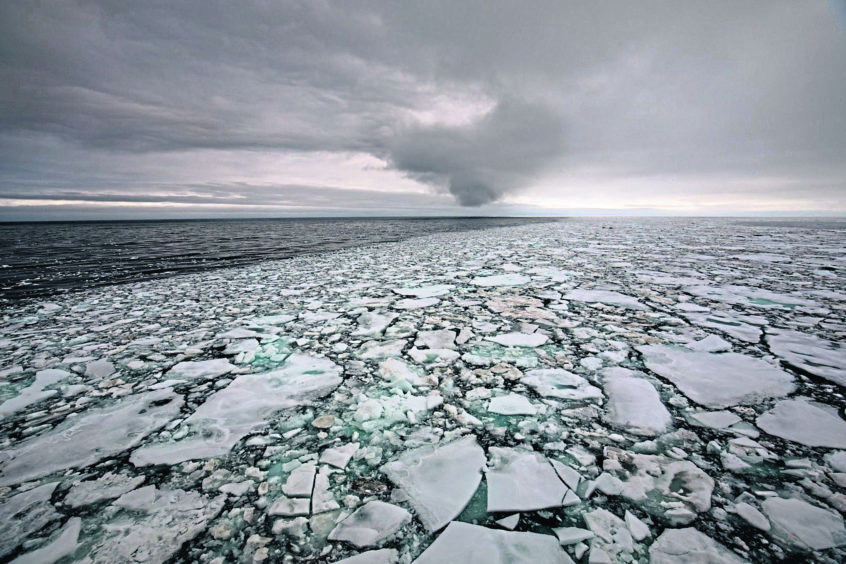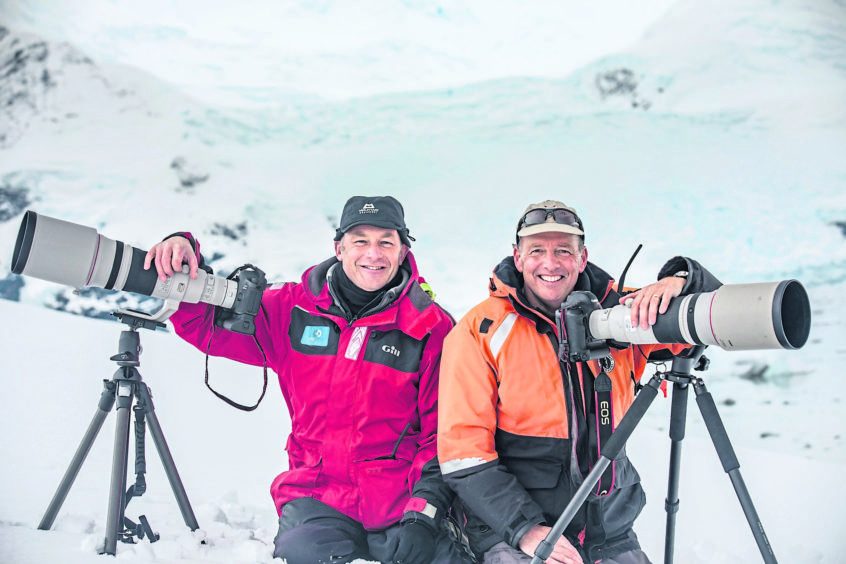Sarah Marshall delves into a world of bears and bergs with polar addicts Chris Packham, Mark Carwardine and Paul Goldstein.
So vast it’s almost overwhelming, uninterrupted sea ice stretches ahead of us, a blank canvas begging for a story to take shape.
Blinded by space, scale and nothingness, I struggle to settle my gaze.
But in an environment that superficially appears empty, the very opposite turns out to be true.
Dwarfed by rising corrugated peaks, a trio of buttery blobs shuffle into view, although in the absence of clear reference points, it’s hard to judge their distance and speed.
Polar bears can reach up to 25mph when running at full pelt, and within minutes, three dots are a family unit, sniffing inquisitively below the bow of our ship.
Nose in the air, a young cub has caught our scent, and although thoughts of breakfast are undoubtedly flashing through his mind, it’s not a sense of danger that’s making my heart skip a beat.
Only metres away, I’m shaken by their guttural growls and hypnotised by plumes of hot breath coiling in the frozen air. It’s the closest I’ve ever been to a polar bear, and incredibly, my adventure has only just begun.
I’m on an expedition vessel traversing the fjords and coastline of Spitsbergen, the main island in Arctic archipelago Svalbard, lying 1,200 miles north of Norway across the Barents Sea.
I’m visiting in mid-June, early in the season, at a time when the rest of Europe is stupefied by sweltering heat. Conversely, Storfjorden, a stretch of water lapping the island’s east coast, is packed with ice – the preferred hunting ground and habitat for ursus maritimus (the polar bear).
Our wildlife encounter could be described as lucky, but wildlife photographer Paul Goldstein, who’s chartered the Akademik Sergey Vavilov for our 12-day voyage, says it’s much more than that.
Every year, the ice shifts and shapes, but conditions don’t dictate everything; a passenger’s experience also depends largely on the expedition crew and the carefully calculated decisions they make.
Since 2004, Paul has visited Spitsbergen 17 times. Add this to his 13 Antarctica visits, and it would be fair to call him a polar addict.
Equally transfixed by the ice, zoologist and conservationist Mark Carwardine is co-leading our trip. In November, the pair will be joined by TV personality Chris Packham on a voyage to the Antarctic Peninsula.
So, what is it that keeps drawing them back to the ice?
“Every day in the polar regions is different,” says Mark, who famously presented BBC radio documentary Last Chance To See with author Douglas Adams.
“The weather changes constantly, the light is different, and you never know what wildlife you might find from one moment to the next.”
He’s right, the thrill of discovery never diminishes – although on this voyage, sightings of one species almost become a daily guarantee.
Our earlier encounter with polar bears is not an isolated incident, and when we meet a mother and her cubs of the year (known as COY) at Torrelnesset, even the experts are filled with teary, first-time wonder.
Predator presence scuppers our plans to visit the walrus colony on Nordaustlandet, Svalbard’s second largest island, and instead we climb into Zodiacs – large inflatable boats – to observe safely from the water.
For more than two hours, we follow the bears along a snow-smothered shoreline, watching mum purposefully carve a path with her sweeping paws, as her young tumble and tussle over powdery mounds.
All the while, we’re at eye level – at times so close every fibre of hair is distinguishable – instantly transporting us into their wild world.
And when curious walruses spy-hop around our boat, ivory sabres hanging like stalactites beneath their frozen whiskers, our attention is torn between two Arctic giants. What a dilemma to have.
“Wildlife photography tends to involve long periods of waiting or searching, without taking a single photograph, and then brief periods of intense shooting when you might take 1,000 pictures in an hour,” Mark had warned us during a lecture on the ship.
Sitting next to me on the Zodiac, he excitedly shoots about three times that amount and later describes the experience as his best polar bear encounter – impressive, considering a chunk of his career has been spent in the ice.
Over the course of our voyage, we clock up a near-incredible 60 bear sightings: exhausted by several unsuccessful hunts, a mother nurses her cubs; at the edge of an ice floe, a muscular male swims from one frozen platform to another. And beneath the glare of a never-setting sun, a family share a seal carcass with a greedy flock of glaucous gulls, the scene silhouetted against one of Svalbard’s trademark aubergine skies.
It’s the highest tally our One Ocean expedition crew has ever recorded in a single Svalbard voyage, and suppositions abound about our good fortune – the bold decision to come early, the proximity of denning sites and again that magic word – luck.
Crucially, we never once disrupt the bears’ habitat, slicing only through thin ice and waiting for wildlife to approach.
Having briefly left the ice for an excursion to the Alkefjellet bird cliffs – a chaos of steep pinnacles swarming with guillemots, kittiwakes and hungry Arctic foxes – we return to find a very different scene; wind and swell have reduced our icy kingdom to open water, making the last few days seem like a dream.
It’s also a reminder of the fragile and transitory environment polar bears inhabit, and a week after we return to the UK, reports suggest sea ice around Svalbard is at an all-time low.
Climate change is a concern for Chris Packham, who’s preparing for his Antarctic trip with Paul and Mark later this year.
He first visited the seventh continent with his step-daughter, Megan, 13 years ago, and even in that time he’s noticed changes.
“On my trip last year, I don’t remember being cold,” he – ironically – shivers when we meet on another atypically hot London day.
“The polar environments are fragmenting,” he says, referring to the Larsen ice shelf, which cracked last year.
“Everyone knows they are visiting a vulnerable and disappearing continent, and that heightens the sense of privilege.”
It’s a privilege that, even after eight polar expeditions, he still appreciates.
“I grew up in a two up, three down, looking at copies of National Geographic in the 1960s and never imagined I’d have the opportunity to travel to the few places on our planet where we can see such large aggregations of wildlife.”
Looking forward to the November departure, he talks enthusiastically about visiting the recently discovered Adelie penguin colony at Danger Islands, and of plans to photograph them aerially with a Go-Pro attached to a 30-metre carbon fibre pole.
Along with Paul and Mark, he’s continually enthralled by polar environments, and their combined passion will no doubt result in a very special voyage.
During our Svalbard expedition, Paul praised his team by recounting Napoleon’s famous quote: “I’d rather have lucky generals than good ones.”
Perhaps he’s right, but with the right alchemy, sometimes you can have both.
The 14-day Special Antarctica Photographic Charter with Paul Goldstein, Mark Carwardine and Chris Packham on the RGCS Resolute departs November 28 2018 and costs from £8,799, excluding flights. Book through exodus.co.uk or call 020 3811 3449.
Chris Packham and Paul Goldstein will also be doing a series of talks throughout early November in London, Glasgow, Cheltenham, Dorking and Buxton. Details to be announced through exodus.co.uk



